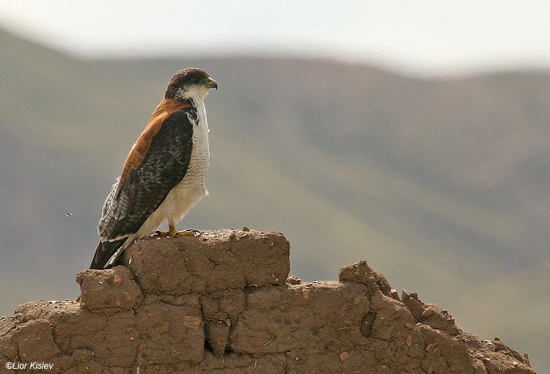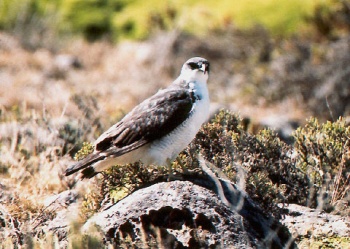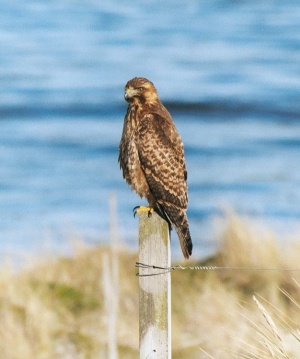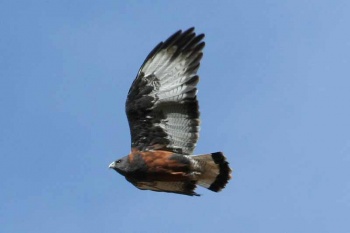m (Red-backed Hawk moved to Variable Hawk) |
(taxonomy, refs, id) |
||
| Line 11: | Line 11: | ||
*Grey back (mantle can be reddish on some individuals) | *Grey back (mantle can be reddish on some individuals) | ||
*White or dark grey underparts<br /> | *White or dark grey underparts<br /> | ||
| − | '''Female''': usually have a rufous mantle but may have either white or rufous or rufous-and-black underparts. | + | '''Female''': usually have a rufous mantle but may have either white or rufous or rufous-and-black underparts. |
| − | The wings fall short of the tip of the tail on the sitting bird | + | |
| + | The wings fall short of the tip of the tail on the sitting bird in the "Red-backed" form while the "Puna" form (formerly a separate species) has wingtips that reach the tip of the tail; this seems to be the best separator of the two forms. | ||
[[Image:18681YoungRedBack.jpg|thumb|300px|right|Juvenile<br />Photo by {{user|zweiblumen|zweiblumen}}<br />Cape Pembroke, [[Falkland Islands]], April 2004]] | [[Image:18681YoungRedBack.jpg|thumb|300px|right|Juvenile<br />Photo by {{user|zweiblumen|zweiblumen}}<br />Cape Pembroke, [[Falkland Islands]], April 2004]] | ||
| Line 18: | Line 19: | ||
[[South America]]: found in [[Colombia]], [[Ecuador]], [[Peru]], [[Bolivia]], [[Chile]], [[Argentina]], and [[Falkland Islands]];vagrant to [[Uruguay]], [[Brazil]]. | [[South America]]: found in [[Colombia]], [[Ecuador]], [[Peru]], [[Bolivia]], [[Chile]], [[Argentina]], and [[Falkland Islands]];vagrant to [[Uruguay]], [[Brazil]]. | ||
==Taxonomy== | ==Taxonomy== | ||
| + | It has been proposed to move this species to genus ''[[:Category:Geranoaetus|Geranoaetus]]'' | ||
====Subspecies<sup>[[#References|[1]]]</sup>==== | ====Subspecies<sup>[[#References|[1]]]</sup>==== | ||
Two subspecies are recognized: | Two subspecies are recognized: | ||
| Line 36: | Line 38: | ||
#BF Member observations | #BF Member observations | ||
# Restall et al. 2006. Birds of Northern South America. Yale University Press. ISBN 9780300124156 | # Restall et al. 2006. Birds of Northern South America. Yale University Press. ISBN 9780300124156 | ||
| + | # [http://www.birdforum.net/showthread.php?t=177760 Birdforum thread] mentioning several taxonomic proposals, of which 460 is relevant here | ||
{{ref}} | {{ref}} | ||
==External Links== | ==External Links== | ||
{{GSearch|Buteo+polyosoma}} | {{GSearch|Buteo+polyosoma}} | ||
[[Category:Birds]] [[Category:Buteo]] | [[Category:Birds]] [[Category:Buteo]] | ||
Revision as of 21:11, 17 May 2011
Alternative name: Red-backed Hawk
- Buteo polyosoma
Includes Puna Hawk
Identification
Male: 18 - 20 in. Female: 20 - 22 in.
- White tail with black sub-terminal band but otherwise very variable in plumage
- Lacks black commas or larger black marks seen on wing underside at the wrist of most similar species
Male
- Grey back (mantle can be reddish on some individuals)
- White or dark grey underparts
Female: usually have a rufous mantle but may have either white or rufous or rufous-and-black underparts.
The wings fall short of the tip of the tail on the sitting bird in the "Red-backed" form while the "Puna" form (formerly a separate species) has wingtips that reach the tip of the tail; this seems to be the best separator of the two forms.
Distribution
South America: found in Colombia, Ecuador, Peru, Bolivia, Chile, Argentina, and Falkland Islands;vagrant to Uruguay, Brazil.
Taxonomy
It has been proposed to move this species to genus Geranoaetus
Subspecies[1]
Two subspecies are recognized:
- B. p. polyosoma - Andes of southern Colombia south to Tierra del Fuego, and Falkland Islands
- B. p. exsul - Juan Fernadez Islands, Chile
There is an active debate as to whether Red-backed Hawk and Puna Hawk are two species or one. Opus follows a consensus according to which it is one, Variable Hawk.
Habitat
Open areas to open forest, but most likely in areas with scrub and some trees in steep terrain. Observed at heights up to around 3000 meters in the north of its range, lower down further south. Where overlapping with Puna Hawk, the form Red-backed Hawk is normally seen at lower elevation.
Behaviour
Diet
Eats primarily mammals but with a significant amount of insects and some birds.
Breeding
It nests in treetops. The nest is large and made of dry sticks. The clutch generally consists of 2 white eggs with light reddish spots.
References
- Clements, JF. 2007. The Clements Checklist of Birds of the World. 6th ed., with updates to October 2007. Ithaca: Cornell Univ. Press. ISBN 978-0801445019
- Avibase
- BF Member observations
- Restall et al. 2006. Birds of Northern South America. Yale University Press. ISBN 9780300124156
- Birdforum thread mentioning several taxonomic proposals, of which 460 is relevant here
Recommended Citation
- BirdForum Opus contributors. (2024) Variable Hawk. In: BirdForum, the forum for wild birds and birding. Retrieved 28 April 2024 from https://www.birdforum.net/opus/Variable_Hawk







